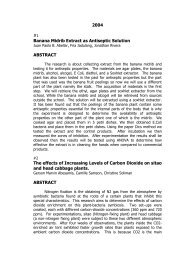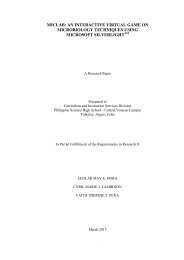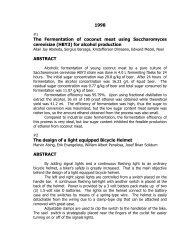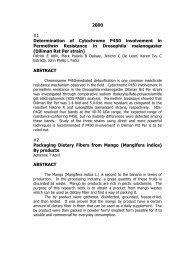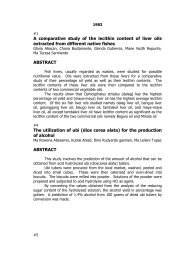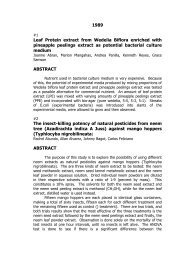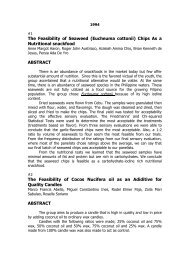2008 Analysis of the Geometry of Drilled Holes in Demolition ...
2008 Analysis of the Geometry of Drilled Holes in Demolition ...
2008 Analysis of the Geometry of Drilled Holes in Demolition ...
Create successful ePaper yourself
Turn your PDF publications into a flip-book with our unique Google optimized e-Paper software.
The project tested <strong>the</strong> feasibility <strong>of</strong> fly ash as a substitute for sand <strong>in</strong> <strong>the</strong><br />
production <strong>of</strong> glass. This was done by us<strong>in</strong>g <strong>the</strong> major components <strong>in</strong> <strong>the</strong><br />
formation <strong>of</strong> glass exclud<strong>in</strong>g sand which was replaced by fly ash.<br />
The project was conducted to help lessen air pollution by mak<strong>in</strong>g use <strong>of</strong> <strong>the</strong><br />
fly ash from burnt coal. This will add to <strong>the</strong> awareness <strong>of</strong> people about <strong>the</strong> uses <strong>of</strong><br />
fly ash. Also, with this project, used glass can be recycled fur<strong>the</strong>r.<br />
From <strong>the</strong> results, it can be concluded that fly ash can be a ma<strong>in</strong> component<br />
<strong>of</strong> <strong>the</strong> batch used to make glass. The glass produced was dark <strong>in</strong> color because <strong>of</strong><br />
<strong>the</strong> fly ash, but it has shown negative results for chemical reactivity and porosity.<br />
Its hardness matched what is set for glass by <strong>the</strong> Mohs hardness scale because it<br />
was not scratched by an iron knife. The project showed that fly ash is a possible<br />
substitute for sand <strong>in</strong> <strong>the</strong> production <strong>of</strong> glass.<br />
Fly ash successfully substituted sand <strong>in</strong> <strong>the</strong> production <strong>of</strong> glass with <strong>the</strong><br />
help <strong>of</strong> some components which lowered its melt<strong>in</strong>g po<strong>in</strong>t. O<strong>the</strong>r use for fly ash<br />
was also discovered, not only for cement but for glass production as well.<br />
#55<br />
Development <strong>of</strong> fortified <strong>in</strong>stant noodles us<strong>in</strong>gMor<strong>in</strong>ga<br />
oleifera and Ipomoea batatasenriched noodles<br />
Hani Herbert L. Ho, Beila B. Angeles, Noelyn Joyce R. Morales<br />
ABSTRACT<br />
Malunggay and kamote leaf puree were used as additives to provide <strong>in</strong>stant<br />
noodles with additional amount <strong>of</strong> vitam<strong>in</strong>s and nutrients. Despite <strong>the</strong> fact that<br />
<strong>in</strong>stant noodles conta<strong>in</strong> certa<strong>in</strong> nutrients, people have come to depend on it for<br />
<strong>the</strong>ir everyday meals, which may lead to vitam<strong>in</strong> and m<strong>in</strong>eral deficiencies.<br />
The leaves were first blanched to remove bacteria before be<strong>in</strong>g pureed.<br />
Each type <strong>of</strong> <strong>in</strong>stant noodles was prepared by mix<strong>in</strong>g flour, egg, kansui, salt,<br />
water and <strong>the</strong> puree. The mixture was kneaded, cut, steamed, and fried. The<br />
noodles were kept at ambient temperature for 10 weeks and were observed<br />
weekly for any changes. Sensory evaluation was done to determ<strong>in</strong>e <strong>the</strong> consumer<br />
acceptability <strong>of</strong> <strong>the</strong> product and proximate analysis to determ<strong>in</strong>e <strong>the</strong> nutritional<br />
content <strong>of</strong> <strong>the</strong> product.<br />
The shelf-life test showed that <strong>the</strong> noodles lasted for 12 weeks without<br />
los<strong>in</strong>g <strong>the</strong>ir edibility, texture, smell and taste. Only <strong>the</strong> crisp<strong>in</strong>ess <strong>of</strong> <strong>the</strong> noodles<br />
decl<strong>in</strong>ed. Proximate analysis showed that <strong>the</strong> fortified <strong>in</strong>stant noodles conta<strong>in</strong>ed<br />
more fat than <strong>the</strong> commercial product, but had slightly more nutrients. It can be<br />
concluded that <strong>the</strong> fortified <strong>in</strong>stant noodles <strong>in</strong>deed have more nutrients and<br />
m<strong>in</strong>erals. However, it does not qualify for commercial production because <strong>of</strong> its<br />
lack <strong>of</strong> appeal, and <strong>the</strong>refore cannot be used as an alternative for commercially<br />
available <strong>in</strong>stant noodles.




